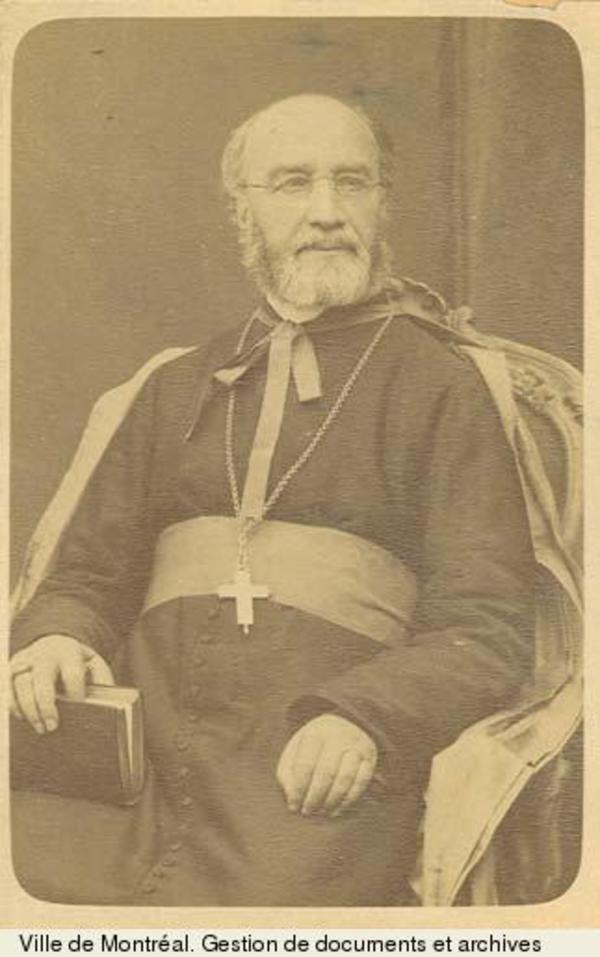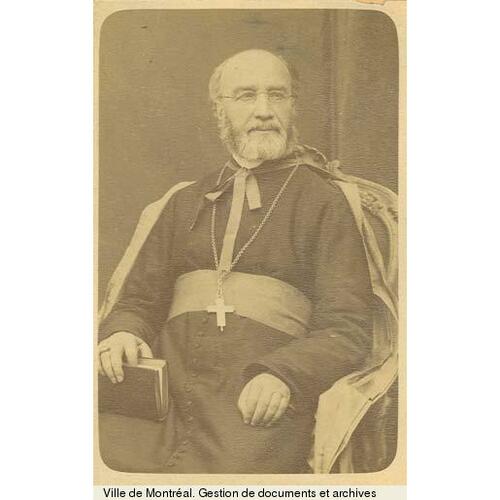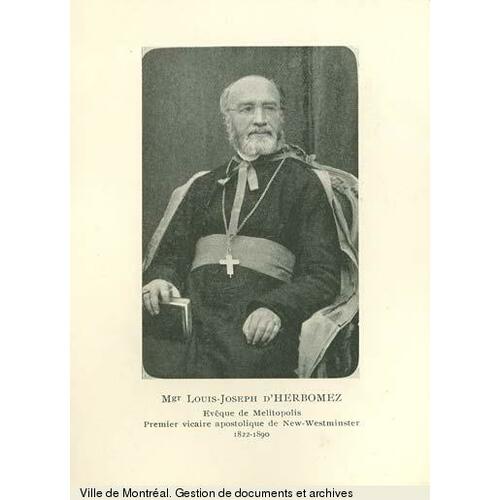
Source: Link
HERBOMEZ, LOUIS-JOSEPH D’, Roman Catholic missionary, priest, and bishop; b. 17 Jan. 1822 at Brillon, dept of Nord, France, son of Louis d’Herbomez and Marie-Alexandrine Bricquet; d. 3 June 1890 at New Westminster, B.C.
Louis-Joseph d’Herbomez worked with his father as a shoeing-smith until he was 17 years old, when he began attending the Cambrai diocesan seminary. On 20 Nov. 1847 he entered the Oblates of Mary Immaculate noviciate at Nancy. He made his perpetual profession on 21 Nov. 1848 and on 14 Oct. 1849 Charles-Joseph-Eugène de Mazenod, bishop of Marseilles and founder of the Oblates, ordained him priest.
Sent to the Oblate missions in the Oregon Territory of the United States in 1850, d’Herbomez served under Father Pascal Ricard, the Oblate superior at Olympia (Wash.). From 1851 to 1853 he worked among the Yakima Indians and established the mission of St Joseph d’Ahtanum; during the last year he moved to Puget Sound to work with the Coast Salish. In 1856 d’Herbomez was appointed visiteur extraordinaire of the Oblate missions in Oregon and in 1858 he succeeded Ricard as missionary vicar.
During their stay in Oregon the Oblates were not able to establish good relations with local American government agents who disliked their working in Indian languages. Even after the Oblates had withdrawn from the Yakima Indian missions in 1855, relations with these agents did not improve; consequently in 1858 the Oblate superiors authorized d’Herbomez to move his headquarters north to Esquimalt (B.C.) in British territory. The Oblates, now under the protection of Modeste Demers*, the French-speaking bishop of Vancouver Island, and the friendly Hudson’s Bay Company officers, planned missions both on the island and on the mainland. On Vancouver Island they started work with the Irish sailors of the Royal Navy, the white settlers, and the Indians from the mission they established at Esquimalt. On the mainland they began to work with the whites and Indians of the Fraser River mines and with the Indians of the Okanagan valley. Despite the influx of miners during the Fraser River gold-rush in 1858, the Indians remained numerically superior to the white population and were the focus of the Roman Catholic missionary efforts.
D’Herbomez’s long-range plan for his missions to the Indians was to establish agricultural villages modelled on the reductions established by the Jesuits for the Indians of Paraguay in the 17th century. In these church-centred villages, separate from the debauched gold-rush towns, the Indians could live a temperate life, learn Christianity and agricultural methods, do public penance for sins, celebrate Catholic feasts instead of traditional Indian ones, and have their children educated in an industrial school. In the early 1860s the Oblates founded several reductions, as well as mission posts at New Westminster, Esquimalt, and Fort Rupert (near present-day Port Hardy) on northern Vancouver Island. From these posts the missionaries travelled to surrounding areas for instructional and liturgical gatherings. For the white population the Oblates, under d’Herbomez’s direction, established parishes and schools, including St Louis College at Victoria.
On 22 Dec. 1863 d’Herbomez was appointed titular bishop of Miletopolis and vicar apostolic of the newly established vicariate of British Columbia. He was consecrated on 9 Oct. 1864 at Victoria by François-Norbert Blanchet and took up his seat in New Westminster a week later. D’Herbomez also retained his position as Oblate superior in British Columbia and over the next year, in an attempt to make the work of his congregation on the mainland autonomous from that of Bishop Demers, removed the Oblate missionary priests and brothers from the island diocese. In 1865 the Oblates established St Louis College at New Westminster. D’Herbomez encouraged the Sisters of St Anne to establish a school for girls there, and, in 1868, another at St Mary’s Mission. By 1869 d’Herbomez had opened 55 chapels in Indian villages, begun developing mission districts such as those at William’s Lake, Stuart’s Lake, and Cranbrook, and made extensive pastoral tours. His health failing from the strain of his work, he had appointed Father Pierre-Paul Durieu*, the director of St Mary’s Mission, as his assistant in 1867.
In 1869 d’Herbomez travelled to Europe to attend the Vatican Council. When he returned to British Columbia he recommended that the federal government set aside reserves for the Indians in existing villages, extinguish Indian title to the lands of the province, give them annual grants for agricultural implements, clothes, and blankets, and appoint Catholic agents for Catholic Indians. He especially requested the establishment of industrial and agricultural boarding-schools for Indian children pointing out that the Oblates had founded some schools of this type and intended to establish one in each mission district.
In June 1875 Durieu was appointed coadjutor bishop. Though still in poor health, d’Herbomez remained active and further expanded his missionary efforts to the Indians of Kamloops in 1878, to the construction crews of the Canadian Pacific Railway in the 1880s, and to the newly incorporated city of Vancouver in 1886. Despite the expansion of Roman Catholic missionary work and the praise given the Oblates for their work among the Indians, the success of the effort was ephemeral. Methodist and Church of England missionaries provided strong competition, and the apparent acceptance of the Oblates by the Indians was belied by their maintaining traditional religious practices and social activities. Moreover, mill and cannery work gave the Indians the funds for maintaining these traditions, and discouraged parents from allowing their children to attend the schools instead of adding to the family income. Although the huge devotional gatherings of Indians during the 1880s seemed to fulfil the early plans of d’Herbomez, the Oblate schools failed to enrol many Indian pupils or, if they did, to train them for long.
By 1887, when d’Herbomez went to Rome to attend the Oblates’ general chapter, his ill health was more pronounced. In 1888 Durieu relieved d’Herbomez of his functions as missionary vicar. Two years later d’Herbomez died of stomach cancer and was buried at St Mary’s Mission. Although it was Durieu rather than d’Herbomez who became known, through the writing of Father Adrien-Gabriel Morice*, as the founder and architect of the Oblate Indian mission villages such as Sechelt, contemporaries of d’Herbomez viewed these mission villages as “the fulfilment of all his dreams.”
L.-J. d’Herbomez was the author of “Letter from his lordship the bishop of Miletopolis and vicar apostolic of British Columbia . . . ,” published in [H.-L. Langevin], British Columbia: report of the Hon. H. L. Langevin, C.B., minister of public works (Ottawa, 1872), 158–60, and of Secular schools versus denominational schools (n.p., 1881).
Arch. hist. oblates (Ottawa), G-LPP, d’Herbomez à Joseph Fabre, 4 févr., 1er juin 1864; 12 août 1867; 12 déc. 1873; 27 sept. 1884; d’Herbomez aux Conseils centraux de la Propagation de la Foi, 12 déc. 1864 (typescript); HPK 5001, “Acte de visite de la maison de Ste Marie du 18 au 25 septembre 1882”; HPK 5241, Paul Durieu à LeJacq, 27 nov. 1883; 23, 25 févr. 1884; HPK 5282, Paul Durieu à d’Herbomez, 14 févr., 15 mars, 1er juin, 25 sept. 1869 (typescript). Can., Parl., Sessional papers, 1873, V: no.23; 1874, VI: no.17; 1875, VII: no.8; 1876, VII: no.9; 1877, VII: no.11; 1878, VIII: no.10; 1879, VI: no.7. Consecration of the Right Rev. Dr. D’Herbomez, O.M.I., which has taken place in the Cathedral of St. Andrews, Victoria, V.I., October 9th, 1864 (21st Sunday after Pentecost) (n.p., n.d.). Missions de la Congrégation des missionnaires oblats de Marie Immaculée (Marseille et Paris), 1 (1862), 2 (1863), 3 (1864), 4 (1865), 6 (1867), 9 (1870), 11 (1873), 17 (1879), 18 (1880), 19 (1881), 22 (1884), 24 (1886), 27 (1889), 28 (1890), 31 (1893). Robert Cooke, Sketches of the life of Mgr. de Mazenod, bishop of Marseilles, and founder of the Oblates of Mary Immaculate, and of the missionary labours and travels of members of that society . . . (2v., London and Dublin, 1879–82), I: 329–46. Kay Cronin, Cross in the wilderness (Vancouver, 1960). Gabriel Dionne, “Histoire des méthodes missionnaires utilisées par les Oblats de Marie Immaculée dans l’évangélisation des Indiens du ‘versant Pacifique’ au dix-neuvième siècle” (thèse de ma, univ. d’Ottawa, 1947). M. M. Down, A century of service, 1858–1958: a history of the Sisters of Saint Ann and their contribution to education in British Columbia, the Yukon and Alaska (Victoria, 1966). Wilson Duff, The Indian history of British Columbia (1v. to date, Victoria, 1964– ), I: The impact of the white man. J. J. [Kennedy] Gresko, “Roman Catholic missionary effort and Indian acculturation in the Fraser valley, 1860–1900” (ba essay, Univ. of British Columbia, Vancouver, 1969). Sœur Marie-Rollande, Mère Marie-Angèle, deuxième supérieure générale des Sœurs de Sainte-Anne, 1828–1898 (Montréal, 1941), 182–85. A.-G. Morice, History of the Catholic Church in western Canada from Lake Superior to the Pacific (1659–1895) (2v., Toronto, 1910), II. “Hommes et choses d’autrefois; un champ d’apostolat trop peu connu: les Oblats dans l’Orégon et la Colombie Britannique,” Petites annales des missionnaires oblats de Marie Immaculée (Paris), 37 (1932): 7, 73. E. M. Lemert, “The life and death of an Indian state,” Human Organization (New York), 13 (1954–55), no.3: 23–27. Wayne Suttles, “The persistence of intervillage ties among the coast Salish,” Ethnology (Pittsburgh, Pa.), 2 (1963): 521–25.
Cite This Article
Jacqueline Gresko, “HERBOMEZ, LOUIS-JOSEPH D’,” in Dictionary of Canadian Biography, vol. 11, University of Toronto/Université Laval, 2003–, accessed April 3, 2025, https://www.biographi.ca/en/bio/herbomez_louis_joseph_d_11E.html.
The citation above shows the format for footnotes and endnotes according to the Chicago manual of style (16th edition). Information to be used in other citation formats:
| Permalink: | https://www.biographi.ca/en/bio/herbomez_louis_joseph_d_11E.html |
| Author of Article: | Jacqueline Gresko |
| Title of Article: | HERBOMEZ, LOUIS-JOSEPH D’ |
| Publication Name: | Dictionary of Canadian Biography, vol. 11 |
| Publisher: | University of Toronto/Université Laval |
| Year of revision: | 1982 |
| Access Date: | April 3, 2025 |




